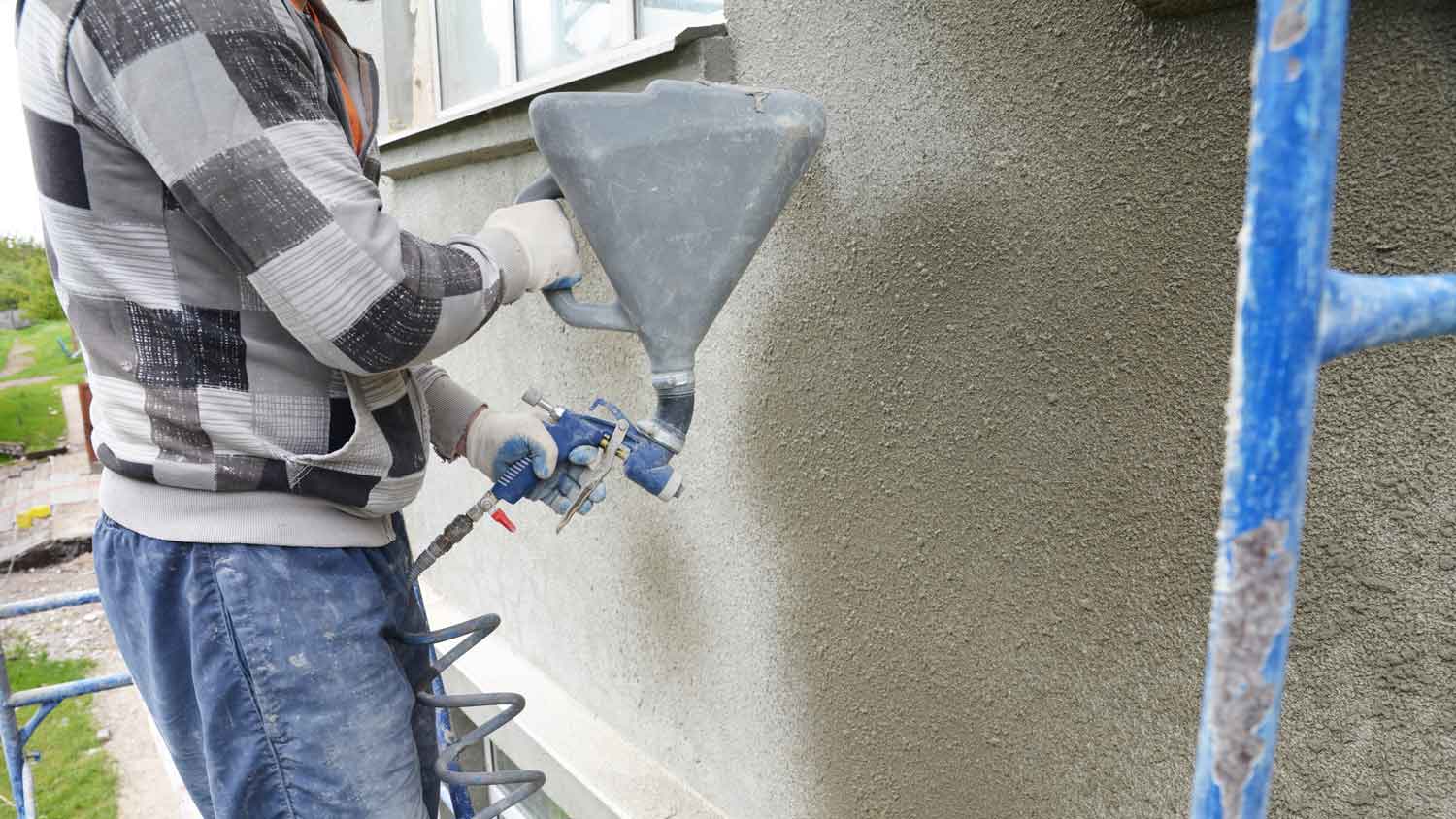
Fiber cement siding is durable, fire-resistant, and affordable. Learn more about fiber cement installation costs in Columbus, OH.
Rain is no threat to properly protected stucco
.jpg)
.jpg)
The cost to waterproof stucco ranges from $500 to $2,000 when hiring a pro, but it might be worth it if you aren’t confident in your application ability.
Waterproofing stucco on a multistory house requires a ladder or lift, which you might need to rent.
If you’re installing and waterproofing new stucco, hire a stucco pro since improperly installed stucco can cause moisture problems and lead to structural damage.
Stucco is one of the longest-lasting and most eye-catching exterior finishes for your home, but it needs to be waterproofed to protect your home and extend its lifespan. We explain four ways to waterproof your stucco so you can have peace of mind that it’s protecting your home for decades to come.
Stucco is a masonry material that consists of cement, lime, sand, and water. Stucco is not waterproof on its own—it’s a permeable material that can absorb and retain water. When it’s used on the exterior of your home, you’ll need to waterproof it to keep moisture from collecting behind the stucco and damaging your home’s exterior walls.
When water makes its way through or behind stucco siding, it causes damage to the exterior walls behind it. This can cause wood rot, damage insulation, and weaken the structural elements of your house.
Water infiltration can cause serious problems with the stucco itself as well. Moisture can cause the stucco to crack, leaving it more vulnerable to further damage. Saturated stucco can also lead to mold and mildew growth, which can discolor the stucco and put your health at risk.

To ensure your stucco is protecting your home from moisture, it should be waterproofed every five to 10 years. The method of waterproofing you should choose depends on the stucco’s condition and environmental concerns. You can also use more than one type of waterproofing to maximize protection.
Most types of stucco will benefit most from a waterproof coating or sealant. This product is applied over the entire surface of the stucco and creates a waterproof barrier without altering the look of the stucco. Stucco sealants can be acrylic-based or elastomeric. Elastomeric sealants are thicker and ideal for older stucco that’s more prone to cracking.
Applying stucco sealant is a straightforward process. Wait until the stucco is fully dry, then paint, spray, or roll the sealant onto the stucco, following the manufacturer’s application and drying instructions.
In addition to overall sealant, you’ll want extra protection for cracks in your stucco and areas around joints, edges, and openings like doors and windows. This type of sealant is used along with surface sealant but is applied only in spots extra vulnerable to water intrusion. It often comes in a tube with a precision nozzle so you can apply it exactly where you need it.
Waterproof stucco paint offers all the benefits of a sealant with the addition of a fresh coat of color. These paints are acrylic-based and create a water-resistant barrier that prevents moisture damage but still allows the wall to release water vapor so it doesn’t get trapped behind the stucco. Stucco paint is available in a wide array of colors and is applied using the same methods as stucco sealant or traditional paint.
If you’re installing stucco for the first time or replacing your stucco siding, first install a waterproof underlayer. This will give your exterior walls an added layer of protection and, when combined with stucco sealant or waterproof stucco paint, will help provide maximum moisture protection for your home’s exterior.
Once your stucco is waterproofed, it’s important to maintain it so it keeps protecting your home from water intrusion and stays in good condition. Failing to maintain your stucco may mean replacing it sooner than expected, and maintenance costs are much more budget-friendly than the cost to stucco a house. To maintain your stucco:
Clean your stucco annually using a soft brush or a low-pressure power washer. Be sure not to use too much pressure or you risk damaging the stucco.
Inspect the stucco around doors and windows seasonally and apply spot sealant where necessary.
Conduct a stucco inspection twice a year, looking for cracks, holes, or other damage that can lead to water infiltration.
Repair any damage as soon as you notice it. Leaving damage unfixed will cause it to get worse over time and increase the amount of water that your stucco and exterior walls will be exposed to.
Waterproofing your stucco by applying sealant or waterproof paint can be a DIY project, as long as you follow all manufacturer’s instructions and ensure a thorough, even application. If you aren’t comfortable on a ladder or aren’t confident in your application abilities, a local stucco pro can tackle the job.
If you’re installing and waterproofing new stucco, it’s best to leave that project to a qualified pro who does stucco. This material can be complex to install, and you need to know how to prep the surface, how to apply the stucco, how long to let stucco dry, and the right way to waterproof it. Improperly installed stucco can cause serious moisture problems, fail to adhere to the exterior walls, and even lead to structural damage. Let the pros handle stucco installation.
Homeowners need to manage moisture to protect the longevity of their siding, which is where weather-resistant barriers come into play. Professional installation, especially with stucco, is essential for preventing cracks as well as keeping the foundation protected.
From average costs to expert advice, get all the answers you need to get your job done.

Fiber cement siding is durable, fire-resistant, and affordable. Learn more about fiber cement installation costs in Columbus, OH.

The cost of siding repair varies depending on material, design, and damage. This helpful guide covers the siding repair costs to expect in Columbus, Ohio.

In addition to protecting against extreme Midwest temperatures, new siding in Columbus adds curb appeal. Learn about siding replacement cost in Columbus.

Regularly cleaning vinyl siding helps your house look better and last longer. Find out how you can tackle this DIY project on your own.

Clapboard siding is classic, reliable, and hardy, but these wooden boards can get damaged in poor conditions. Here’s how to do a DIY repair for clapboard siding.

Frieze board can transform a home by adding depth and style. Keep reading to learn what frieze board is and how to use it to enhance your home’s appearance.